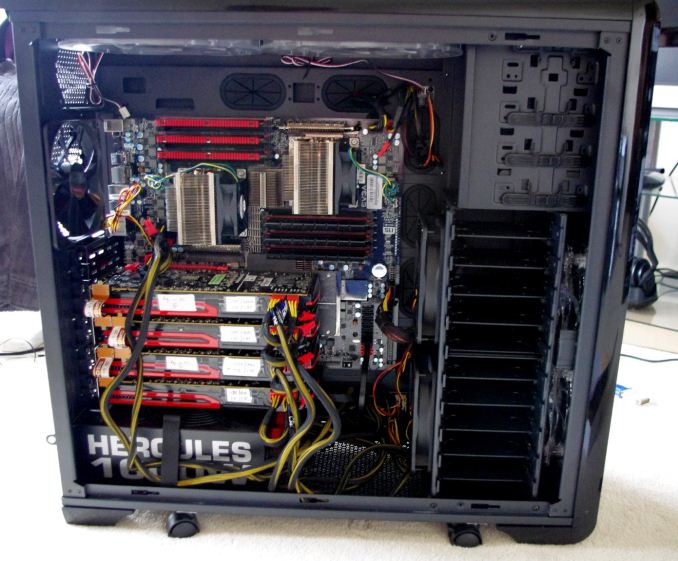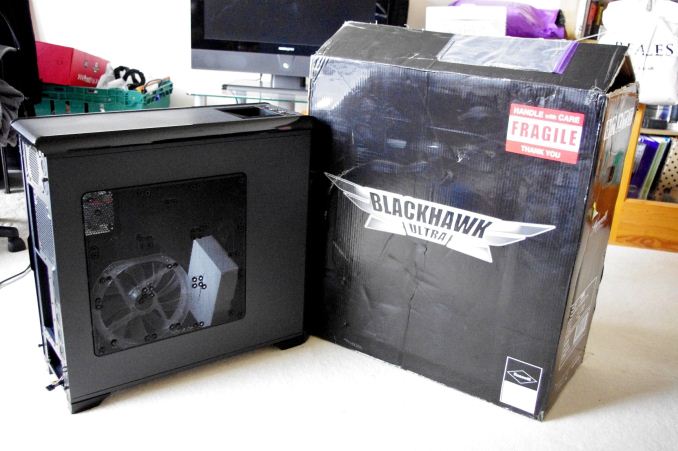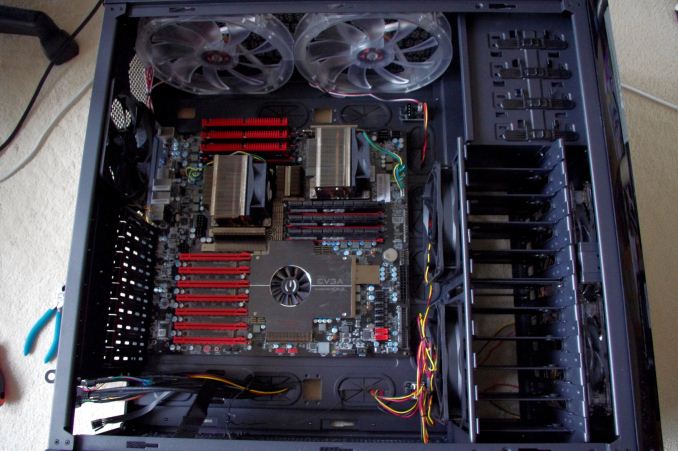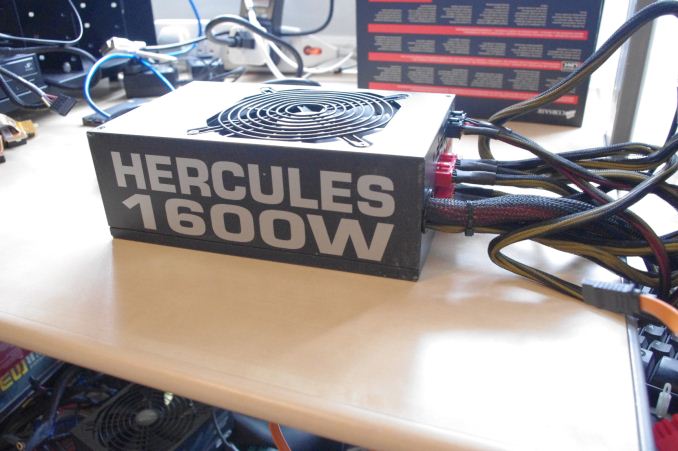Choosing a Gaming CPU: Single + Multi-GPU at 1440p, April 2013
by Ian Cutress on May 8, 2013 10:00 AM ESTTo start, we want to thank the many manufacturers who have donated kit for our test beds in order to make this review, along with many others, possible.
Thank you to OCZ for providing us with 1250W Gold Power Supplies.
Thank you to G.Skill for providing us with the memory kits.
Thank you to ASUS for providing us with the AMD GPUs and some IO Testing kit.
Thank you to ECS for providing us with the NVIDIA GPUs.
Thank you to Corsair for providing us with the Corsair H80i CLC.
Thank you to Rosewill for providing us with the 500W Platinum Power Supply for mITX testing, a BlackHawk Ultra, and 1600W Hercules PSU for extreme dual CPU + quad GPU testing, and RK-9100 keyboards.
Thank you to Gigabyte for providing us with the X5690 CPUs.
Also many thanks go to the manufacturers who over the years have provided review samples which contribute to this review.
Testing Methodology
In order to keep the testing fair, we set strict rules in place for each of these setups. For every new chipset, the SSD was formatted and a fresh installation of the OS was applied. The chipset drivers for the motherboard were installed, along with NVIDIA drivers then AMD drivers. The games were preinstalled on a second partition, but relinked to ensure they worked properly. The games were then tested as follows:
Metro 2033: Benchmark Mode, two runs of four scenes at 1440p, max settings. First run of four is discarded, average of second run is taken (minus outliers).
DiRT 3: Benchmark Mode, four runs of the first scene with 8 cars at 1440p, max settings. Average is taken.
Civilization V: One five minute run of the benchmark mode accessible at the command line, at 1440p and max settings. Results produced are total frames in sets of 60 seconds, average taken.
Sleeping Dogs: Using the Adrenaline benchmark software, four scenes at 1440p in Ultra settings. Average is taken.
If the platform was being used for the next CPU (e.g. Maximus V Formula, moving from FX-8150 to FX-8350), there's no need to reinstall. If the platform is changed for the next test, a full reinstall and setup takes place.
How to Read This Review
Due to the large number of different variables in our review, it is hard to accurately label each data point with all the information about that setup. It also stands to reason that just putting the CPU model is also a bad idea when the same CPU could be in two different motherboards with different GPU lane allocations. There is also the memory aspect to consider, as well as if a motherboard uses MCT at stock. Here is a set of labels correlating to configurations you will see in this review:
CPU[+][(CP)] (PCIe version – lane allocation to GPUs [PLX])
First is the name of the CPU, then an optional + identifier for MCT enabled motherboards. (CP) indicates we are dealing with a Bulldozer derived CPU and using the Core Parking updates. Inside the parentheses is the PCIe version of the lanes we are dealing with, along with the lane allocation to each GPU. The final flag is if a PLX chip is involved in lane allocation.
Thus, for example:
A10-5800K (2 – x16/x16): A10-5800K with two GPUs in PCIe 2.0 mode
A10-5800K (CP) (2 – x16/x16): A10-5800K using Core Parking updates with two GPUs in PCIe 2.0 mode
FX-8350K (2 – x16/x16/x8): FX-8350 with three GPUs in PCIe 2.0 mode
i7-3770K (3/2 – x8/x8 + x4): i7-3770K powering three GPUs in PCIe 3.0 but the third GPU is using the PCIe 2.0 x4 from the chipset
i7-3770K+ (3 – x16): i7-3770K (with MCT) powering one GPU in PCIe 3.0 mode
i7-3770K+ (3 – x8/x8/x8/x8 PLX): i7-3770K (with MCT) powering four GPUs in PCIe 3.0 via a PLX chip
Common Configuration Points
All the system setups below have the following consistent configurations points:
- A fresh install of Windows 7 Ultimate 64-bit
- Either an Intel Stock CPU Cooler, a Corsair H80i CLC or Thermalright TRUE Copper
- OCZ 1250W Gold ZX Series PSUs (Rosewill 1600W Hercules for The Beast)
- Up to 4x ASUS AMD HD 7970 GPUs, using Catalyst 13.1
- Up to 2x ECS NVIDIA GTX 580 GPUs, using GeForce WHQL 310.90
- SSD Boot Drives, either OCZ Vertex 3 128GB or Kingston HyperX 120GB
- LG GH22NS50 Optical Drives
- Open Test Beds, either a DimasTech V2.5 EasyHard or a CoolerMaster Test Lab
AMD Configurations
A6-3650 + Gigabyte A75-UD4H + 16GB DDR3-1866 8-10-10
A8-3850 + ASRock A75 Extreme6 + 16GB DDR3 1866 8-10-10
A8-5600K + Gigabyte F2A85-UP4 + 16GB DDR3-2133 9-10-10
A10-5800K + Gigabyte F2A85-UP4 + 16GB DDR3-2133 9-10-10
X2-555 BE + ASUS Crosshair V Formula + 16GB DDR3 1600 8-8-8
X4-960T + ASUS Crosshair V Formula + 16GB DDR3-1600 8-8-8
X6-1100T + ASUS Crosshair V Formula + 16GB DDR3-1600 8-8-8
FX-8150 + ASUS Crosshair V Formula + 16GB DDR3-2133 10-12-11
FX-8350 + ASUS Crosshair V Formula + 16GB DDR3-2133 9-11-10
FX-8150 + ASUS Crosshair V Formula + 16GB DDR3-2133 10-12-11 + CP
FX-8350 + ASUS Crosshair V Formula + 16GB DDR3-2133 9-11-10 + CP
Intel Configurations
E6400 + MSI i975X Platinum + 4GB DDR2-666 5-6-6
E6700 + ASUS P965 Commando + 4GB DDR2-666 4-5-5
Celeron G465 + ASUS Maximus V Formula + 16GB DDR3-2133 9-11-11
i5-2500K + ASUS Maximus V Formula + 16GB DDR3-2133 9-11-11
i7-2600K + ASUS Maximus V Formula + 16GB DDR3-2133 9-11-11
i3-3225 + ASUS Maximus V Formula + 16GB DDR3-2400 10-12-12
i7-3770K + Gigabyte Z77X-UP7 + 16GB DDR3-2133 9-11-11
i7-3770K + ASUS Maximus V Formula + 16GB DDR3-2400 9-11-11
i7-3770K + Gigabyte G1.Sniper M3 + 16GB DDR3-2400 9-11-11
i7-3930K + ASUS Rampage IV Extreme + 16GB DDR3-2133 10-12-12
i7-3960X + ASRock X79 Professional 16GB DDR3-2133 10-12-12
Xeon X5690 + EVGA SR-2 + 6GB DDR3 1333 6-7-7
2x Xeon X5690 + EVGA SR-2 + 9GB DDR3 1333 6-7-7
The Beast
The Beast is a special machine put together to help with the review as a result of various hardware coming into my possession all at the same time. The core of the system is an EVGA SR-2 motherboard, the best and last dual processor motherboard to deal with overclockable Xeon processors. This is paired with a couple of X5690 Xeon processors, the highest clocked Westmere Xeon that Intel offers, and many thanks to Gigabyte for loaning these to us for a pair of reviews. I went and purchased a pair of Intel Xeon socket 1567 coolers for the system, which have a 2U z-height restriction but are copper piped and cooled by powerful (and loud) delta fans. These provided enough cooling power to push the Xeons from 3.43GHz to 4.6GHz during some overclocking attempts, so are more than adequate for the job at hand (if you can put up with the noise).
Our system is paired with some high quality DDR3 Hyper memory, once famed for its overclocking prowess but due to frequent deaths from high voltage, is now relegated as a memory for overclockers. However at stock this memory performs great, often in the region of DDR3-2000 C7, so our memory kits are well primed for this setup.
Of course a full system is nothing without a case and power supply to help justify a build. With the motherboard being absolutely huge, no standard case would take it – only large cases designed for desktop-based server 2P motherboards are adequate. Luckily there is one case which is selling well, and Dustin reviewed recently – the Rosewill Blackhawk Ultra. Aside from the weight, this case had no issues with installing the motherboard; it could easily fit in another 10 HDDs, four optical bays, and any major GPU setup you could possibly think of – with plenty of fans just for good measure. Read Dustin’s review for a more thorough analysis, but I have some good shots of the system and motherboard installed for you:
Rosewill also has the perfect power supply for dealing with a dual processor, quad CrossFireX setup. First, consider how many connections this 2P setup needs – we have a normal 24-pin ATX connector for the motherboard, one 8-pin CPU power connector for each CPU, an additional 6-pin PCIe power connector for each CPU to provide extra power, another 6-pin PCIe power connector to provide power to the PCIe slots, and then two 6+2 PCIe power connectors for the GPUs. That makes 11 PCIe connectors needed in total, and this is alongside all the fans in the case and whatever SSD/ODD setup a user wants. The power supply used for this monster is the 1600W Hercules, rated 80PLUS Silver. With access to 16 PCIe connectors, the only way you might need any more is with a compute rig having seven single slot cards each needing two connectors. With the CPUs and GPUs both overclocked, our system was drawing almost 1500W at the wall (at a 240V source) under a high CPU+GPU load.
Using a 2P system as a desktop comes with its own set of issues, namely some CPU benchmarks not optimized for 2P, or in this case, some trouble getting some games to even work. It seems that the more money you can throw at a gaming system the more problems start to arise, but The Beast provides a nice comparison point when we look at high-end Ivy Bridge, Sandy Bridge-E and Piledriver processors in multiple-GPU setups.
Our first port of call with all our testing is CPU throughput analysis, using our regular motherboard review benchmarks.
































242 Comments
View All Comments
Pheesh - Wednesday, May 8, 2013 - link
"2) Min FPS falls under the issue of statistical reporting. If you run a game benchmark (Dirt3) and in one scene of genuine gameplay there is a 6-car pileup, it would show the min FPS of that one scene. So if that happened on an FX-8350 and min-FPS was down to 20 FPS when others didn't have this scene were around 90 FPS for minimum, how is that easily reported and conveyed in a reasonable way to the public? A certain amount of acknowledgement is made on the fact that we're taking overall average numbers, and that users would apply brain matter with regard to an 'average minimum'."The point of a benchmark is to provide a consistent test that can be replicated exactly on multiple systems. If you're not able to do that then you aren't really benchmarking anything. That's why 99% of games are not tested in multiplayer but rather single player in experiences they can strictly control. (i.e. with test demos). If for some reason the game engine is just that unpredictable even in a strictly controlled test situation you could do multiple trials to take a minimum average.
Minimum FPS is an extremely necessary test and its easily possible to do. Other sites include it with all of their gaming benchmarks.
Spunjji - Wednesday, May 8, 2013 - link
That doesn't necessarily mean that the numbers they give you are worth a damn...beginner99 - Thursday, May 9, 2013 - link
"Minimum FPS is an extremely necessary test and its easily possible to do. Other sites include it with all of their gaming benchmarks."Or you could do 5 runs, discard the worst and best and average the rest (min, max average FPS).
http://en.wikipedia.org/wiki/Truncated_mean
But yeah statistics is extremely complex and error prone. I once read that a large amount of statistics in scientific publications have errors to a certain degree (but not necessarily making the results and conclusions completely wrong!!!)
Or if you actually know such a "special scene" can happen, discard all test were it happened.
beginner99 - Thursday, May 9, 2013 - link
The main issue here is actually available time or the amount of work. Averages over 3 aren't really that great. if you could run everything 100 times such "special scenes" would be irrelevant.mapesdhs - Monday, May 20, 2013 - link
Ian,
P55 boards can offer very good RAID0 performance with SSDs, or more importantly
RAID1 or RAID10 (I hope those with RAID0 have some kind of sensible backup
strategy). See my results:
http://www.sgidepot.co.uk/misc/ssd_tests.txt
One will obviously get more out of newer SSDs using native SATA3 mbds for the
sequential tests, but newer tech won't help 4K numbers that much. In reality few
would notice the difference between each type of setup. This is especially true
given how many later mbds use the really awful Marvell controllers for most of the
SATA3 ports (such a shame only a couple are normally controlled by the Intel or
other chipset); performance would be better with an older Intel SATA2. I expect
many just use the non-Marvell ports only if they can.
What matters is to have an SSD setup of some kind in the 1st place. My P55 system
(875K) boots very quick with a Vertex3, gives a higher 3DMark13 physics score than
a 3570K, and GPU performance with two 2x 560Ti is better than a stock 680. It's
really the previous gen of hw which can present more serious bottlenecks (S775,
AM2, DDR2, etc.), but even then results can often be surprisingly decent, eg. oc'd
Ph2 965, etc.
Also, RAID0 with SSDs often negates the potential of small I/O performance.
Depending on the game/task, this means SSD RAID0 might at times be slower than a
single good SSD.
Dribble is right in that respect, improvements are often not as significant as
people think or expect (I've read sooo many posts from those who have been
disappointed with their upgrades), though it does vary by game, settings, etc.
Games which impose a heavier CPU loading (physics, multiplayer, AI etc.) might see
more useful speedups from a better CPU, but not always. There are so many factors
involved, it can become complicated very quickly.
Ian.
Felix_Ram - Sunday, May 26, 2013 - link
Your 120 hz screen has a frame latency of about 8 ms. Meaning it effectively can't show you more than 60 new fps. Anything above that it shows you the same pixel twice. So basically, you are watching reruns, and anyone who states that he can tell a difference between 60 fps and +60fps is basically kidding himself.http://forums.anandtech.com/showthread.php?t=23049...
http://forums.steamgames.com/forums/showthread.php...
Felix_Ram - Sunday, May 26, 2013 - link
Can't edit. A screen latency of about 16 ms*tehh4ck3r - Wednesday, May 8, 2013 - link
You should test a Phenom II X4-965 and a i5-3570K.B-Unit1701 - Wednesday, May 8, 2013 - link
And throw in a 45nm Core2, preferably over 3.0Ghzboulard83 - Wednesday, May 8, 2013 - link
Really great review and testing. As for the CPU to add to the list, you could add some very cheap solution like the G1610 and G2020 too see how these 40-60$ chip perform againts all other chip or simply compare to an older E6700 like the one on the test. Other than that, you could also add a 3820 in the testing simply to lower the cost of the X79 setup, making it a little more mainstream VS a 600$ 3930k.